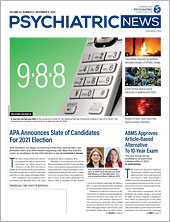In my preceding presidential columns on structural racism in American psychiatry and APA, I have tried to trace how unquestioned assumptions of white supremacy (supported by or masquerading in the guise of pseudo-scientific notions of Black inferiority) have permeated our history from its beginning. Recall that Benjamin Rush, long revered as the father of American psychiatry, owned a slave (despite being an abolitionist) and proposed a disease called “Negritude”—fundamentally declaring Black skin a disease. Moreover, segregation of Blacks in psychiatric hospitals—and later hospitals built exclusively for Blacks—was a long-standing policy in this country. This history of systemic racism has affected all aspects of psychiatry—research, treatment, and advocacy and the staffing and leadership structure of our Association.
In a previous column, I highlighted APA’s own history with a description of the dramatic encounter at the Board of Trustees in 1969 when a group of Black psychiatrists led by Chester Pierce, M.D., delivered nine demands aimed at eradicating racism within the organization and American psychiatry (including academic institutions that recruit and train psychiatrists and agencies that fund research such as the National Institute of Mental Health). None of the demands they made were “radical” by any definition; it is a sobering confirmation of the reality of structural racism in American society that such elemental demands needed to be made 125 years after the founding of the APA.
Fast forward to May 25, 2020, and the killing of George Floyd at the hands of Minneapolis police. In the midst of a global pandemic, virtually every agency and institution in America began a reckoning with the persistence of racism. So too did APA, and we asked ourselves: How much has changed since those eminently reasonable demands were presented in 1969?
Surely, it would be unfair to say that nothing has changed. Our organization—leadership and membership—is markedly more diverse than it was 50 years ago. But the representation of Blacks in American medicine, including psychiatry, is still not anywhere near where it should be, and health disparities remain rooted in inequities—in housing, health care, employment, and education—that go back generations.
In June I created the Presidential Task Force to Address Structural Racism Throughout Psychiatry, chaired by Board member Cheryl Wills, M.D., and comprising a diverse array of thought leaders and Board and Assembly members. The processes of the task force are intended to be collaborative, inclusive, and member informed. Task force members are ambassadors for the project and are expected to interface with members, share information, accept suggestions and other forms of feedback, and share their experiences with other task force members. While presidential task forces usually end with the end of a president’s term, the plan is to transform the task force into a committee with an expectation its work will continue for many years.
Brief surveys have been conducted regarding structural racism in organized psychiatry and patient care. A survey on the impact of racism on psychiatric practice was conducted last month.
The task force has met with all of the APA councils and is meeting with APA committees and APA Areas and district branches. Two of five town halls have been held: the first dealt with the impact of structural racism on Blacks in health care and the legal system and the challenge of building healthy communities as a way to diminish health disparities; the second town hall dealt with the history of structural racism in medicine and psychiatry and its effects on children, their families, and LGBTQ communities.
The other town halls will address transgenerational trauma and mental health (November 16), growing a diverse and inclusive mental health workforce (February 8, 2021), and lessons learned from the first year of the task force’s work. The latter will take place during the APA Annual Meeting in May 2021.
The task force has several work groups that are looking critically at structural racism within APA itself, gathering and analyzing data on the diversity of members within the governance structure—Board, Assembly, councils, committees, and fellowship and research programs. Work groups are charged with identifying actionable items to address any disproportionate representation that can be submitted to the Board of Trustees for approval. The first set of action items was presented to the Board of Trustees at its October meeting (
see story).
At the administration and staff level, the task force has recommended that each APA division chief include a section on diversity and inclusion in its reports to the Board. Additional work groups will be appointed to address structural racism in workforce development and psychiatric practice, including patient care.
Perhaps the most important goal of the task force is to encourage APA internal and affiliated groups to initiate their own projects on structural racism, so that this will be a “living” process that will be ongoing. There are promising developments already: Several Areas and district branches have initiated educational programs on structural racism, diversity, and inclusion. For example, the Ohio district branch plans to have a remote residency recruitment event to attract minority and underrepresented medical students to psychiatry residencies in the state. Area 1 developed a protocol it will follow at all its meetings to ensure racism is considered throughout all its actions. Other Areas are considering adopting this protocol for their meetings (see box).
So .... we have made a start on a process of self-examination that is bound to be a long-term project—and one that is not going to be painless or comfortable. Our Black colleagues have told us that an authentic reckoning with racism and the way white supremacy is built into our institutional structure will be difficult; indeed, we should probably acknowledge that if it isn’t difficult, it isn’t authentic. “Not everything that is faced can be changed,” said James Baldwin, “but nothing can be changed until it is faced.”
Personally, I am hopeful. I am convinced that together we can face our own history, own it, and build a future in which diversity throughout APA and psychiatry occurs organically and ceases to be an issue demanding solutions. We should have set that goal for ourselves 50 years ago. The process we have begun of looking critically at ourselves will benefit all of us, confirming (albeit redundantly) the truth of that old truism—which psychiatrists know better than most—that there is no way out but through. ■

